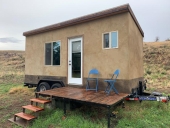


ONE guy seems to have done his heatpump minisplit system up perfectly though. Key, is he does his own maintenance. And…
He placed his heatpump into the middle of his south-faced solar array, encased in its own greenhouse…
…in winter, a fan draws warmed air to ventilate it, from the house crawlspace. That prevents it icing-up, so, it runs more efficiently.
…during summer, he uses the fan to blow the hot heatpump air outside via a vent, & can also shade its greenhouse, again, helping it run more efficiently.
The heatpump runs off his solar array (big array, maybe about 10’x20’).
Heat pumps emit cold air outside in winter, & hot air outside, in summer—you don’t want them placed near an entry door or a commonly opened window.
It also makes me wonder, how much the heatpumps contribute, directly & indirectly, to yet more warming the area they are in?…cities already are warmer than rural areas around them, just from so many tempered bldgs., hard-scapes, & hot roofs.
Heat emitted from using A/C, adds to warming.

Creighton Samuels wrote:
Steven A Smith wrote:I scanned through most of this (12 year old, very long) thread and didn't see much reference to the use of literal *heat lamps*.
Actually, many before you have mentioned using incandescent (heat) lamps to both directly heat & illuminate a space or a person. I can understand if you overlooked those posts, since this thread is, indeed, 12 years in the running. What you seem to be describing in the rest of your post is commonly referred to as a "heat bubble" here, after the research & resulting article/video by Paul Wheaton that started this thread. True incandescent bulbs have become hard to find in the US these days, unless they are of the red light kind, due to regulatory reasons.





Stacy Witscher wrote:To my mind, the overuse of the word addiction has diminished actual addiction issues.
Divorce is not bad. Staying in abusive or unfulfilling relationships is bad.
Children don't need a mother and father, they need people who love and respect them as people regardless of relationships.
Brainwashing your children with your religious or political beliefs is child abuse.

Jim Morrison wrote:
A friend of mine that is a shrink, she told me a few years ago she has as many women addicted to porn as men.
